


1792 Baviere Chevauleger Leiningen Casque à la Rumford Bruxelles
English Translation
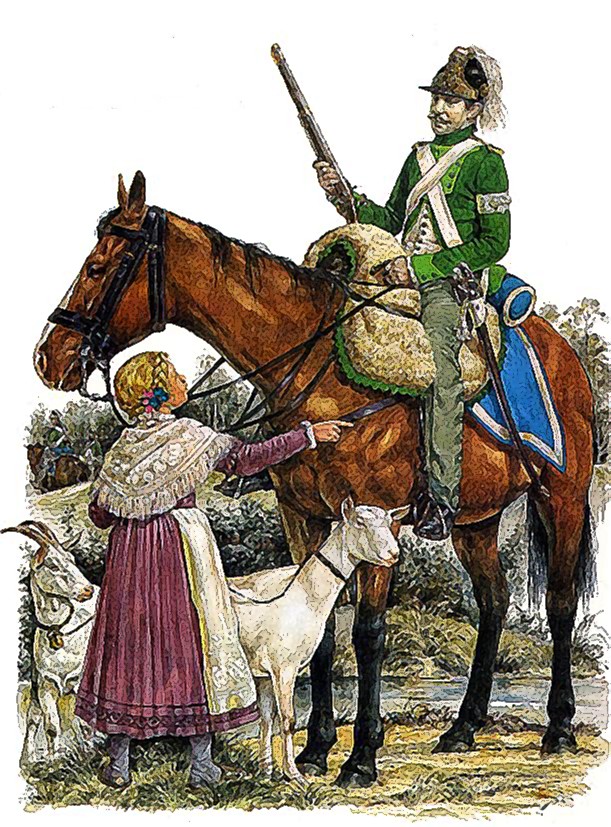 |
|
Casque dit à la Rumford 1792 Osprey |
Historique Voir ICI
History Click HERE
Historique du Königlich Bayerisches 2. Chevauleger-Regiment Taxis "
Le Königlich Bayerisches 2. Chevauleger-Regiment Taxis " est un des plus anciens régiments de cavalerie bavaroise; il fut créé en le 29 juin 1682 lors de la création de l'armée permanente par le jeune Electeur Bavarois( Kurfürsten) Maximilian II. Emanuel ("Der blaue König " ) Ce régiment fut commandé par Louis marquis de Beauvau de Croan " .Ce fut d'abord un régiment de cuirassiers , qui devint en 1790 un régiment de dragons , piur devenir en 1811 une régiment de Chevauleger régiment , passant aisni d e la cavalerie à la cavalerie légère
Dans son histoire le regiment a changé maintes fois de garnsions. vous allez trouver si apres les noms des diverses villes de garnisons: Dingolfing , Ried , Braunau , Ulm , Memmingen , Amberg , Wasserburg , Rosenheim , Neumarkt ok , Munich , Ingolstadt , Neuoetting , Landsberg , Speyer , Zweibrücken , Ansbach , Dillingen / Donau (1872 - 1909) et à partir de 1909 jusqu'à la dissolution Ratisbonne .
Depuis 1747 , le régiment reçoit le nom de " Taxis " ,car il est étroitement liée à la maison de Thurn et Taxis donc le prrince était un des chefs du régiment .
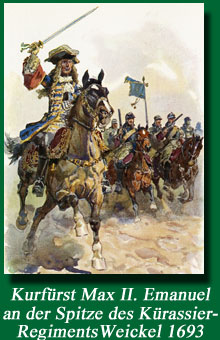 |
| internet |
L'Électeur cré donc ce regiment en 1682 au camp à Schwabing , et en 1688 débute la guerre contre les Turcs en Hongrie suite au siège de Vienne . Le point culminant a été la prise de Belgrade par les troupes de l'électeur en 1688 ,qui sont les ordres de l'Empereur Léopold Ier. L'action des cuirassiers bavarois a été décisive.
Quand Louis XIV en 1689 ,envahit le Rhin Palatinat les troupes bavaroises sont retirés du Front Hongrois aisni que la majeure partie de l'armée bavaroise pour combattre sur le front de l'Ouest de 1689 à 1697
Apres une brève période de paix , durant laquelle le régiment a dû etre démonté pour abaisser les couts d'entretien commence en 1702 la Guerre de Succession d'Espagne qui voit la Baviere se ranger aux coté de la france contre les Alliés qui sont l'Empire et les puissances maritimes Angleterre et Hollande . Tout d'abord, l'armée Bavaroise remporte des succés en 1703 mais en 1704 , les troupes franco Bavoires subissent des reversé nottament à Blenheim . AinsiI l'elcteur doit abandonner sa progressionv ers les Pays pour revenir en centre Europe La guerre continue jusqu'en 1713 /1714.A cette époque la Bavière ne pouvant plkus fournir en nombre suffisant des soldats le régiment recrute de nombreux français et néerlandais
Apres la guerre le regiment retourne dans ses casernements bavarois et l'armée face aux problèmes fianciers subit des coupes sombres .
Durant cette premiere partie du XVIIIe siecle la Baviere va faire les frais de diverses campagnes militaires nottamement durant la guerre de sucession d'Autriche qui débute avec la mort de l'empereur Charles VI en 1740 sans postérité masculine
Monte sur le trone impérial sa fille Marie-Thérèse ,ce qui déclenche les revendications des divers grands électeurs sur les terres héréditaires autrichiennes. Karl Albrecht de Baviere même couronné Empereur comme Charles VII combat dans la guerre de Succession d'Autriche de 1741 jusqu'à sa mort prématurée en 1745 contre les Autrichiens . Le régiment prend part à cinq campagnes durant lesquelles on voit la Baviere passer de mains en mains
Le nouvel électeur Max III. Joseph conclut immédiatement la paix avec Marie-Thérèse et combat aux coté des troupes autrichiennes jusqu'en 1748 puis durant la guerre de Sept Ans , 1757-1762 .
Duran cette guerre le régiment n'y participe pas car il est démobilé etant sans chevaux.
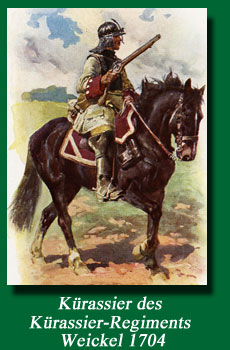 |
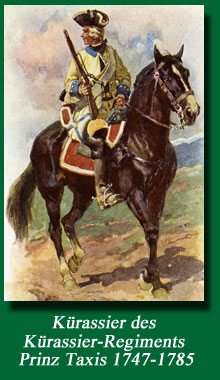 |
Le régiment est reformé comme régiment de cavalerie , en 1785 et devient en 1786 un régiment de cuirassiers pour passer en 1790 régiment de dragons , ce qui le fait passer dans la cavalerie légère .
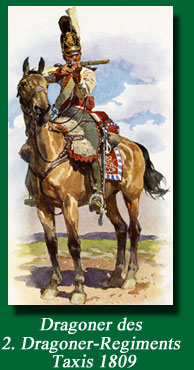 |
La longue période de paix prend fin avec le debut des guerre révolutionnaire et napoléoniennes .
En 1800 le régiment luttre contre la France du côté de l'Autriche campagne qui s'achéve par la désastreuse bataille de Hohenlinden .. Suite à cela avec le nouvel Electeur Max IV Joseph la Bavière se range aux cotés des français
Elle y gange des térritoire et la couronne Royale Le régiment combat donc aux coté des troupes françaises en 1805 contre l'Autriche et en 1806 à 1807 contre la Prusse en particulier en Silésie .
La guerre de 1809 voit durant la bataille d'Eckhmull le 22 Avril la conduite héroïque du Regiment En effet durant cette bataille la Brigade de Cavalerie Seydewitz ( Taxis Dragoner und Bubenhoven Chevaulegers; jetziges 2. und 6. Chevauleger-Regimentt) mene une action décicisive contr les positions d'artillerie autrichiennes capturant 16 canons . Le Général Seydewitz est promu Ritter des Max-Joseph-Ordens
En 1812, le régiment entre en Russie comapgne durant laquelle il est presque anéanti . En 1813 il est réorganisé en Bavière et après la batailles de Liepzig qui voit la défection des alliés allemands il prend par aux cotés des Coalisés aux diverses camapgnes qui conduisent à la fin de l'Empire Français
Le régiment participe à la bataille de Hanau (28 à 30 Octobre 1813) et la capture de Châlons (5 Juillet 1815)
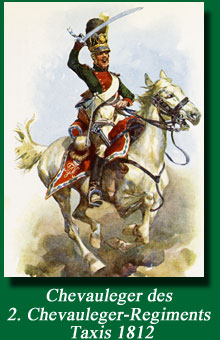 |
entre temps le régiment . Fürst von Thurn und Taxis était transformé le 29 Avril 1811- en 2. Chevauleger-Regiment "Fürst von Thurn und Taxis" il devient Königlich Bayerisches 2. Chevauleger-Regiment "Taxis" en 1848 nom qu'il portra jusqu'à sa dissolution en 1918
L'uniforme change aussi En effet depuis 1682 il portait un uniforme jaune ou blanc ,En 1790 l'uniforme change pour une couleur verte ( cavalerie légère) En 1815 il est caserné à Ansbach dos .
Durant la guerre de 1866 contre la Prusse le régiment est engagé dans 4 batailles sur la Tauber piur ensuite revenir à Ansbach .
Pendant la guerre de 1870 à 1871 contre la France , le régiment fait parti du II. bayerischen Armee-Korps en tant que Divisions-Kavallerie ( cavalerie divisionnaire)
Il combat autour de Sedan en Septembre , 1870) et prends part au siège de Paris.
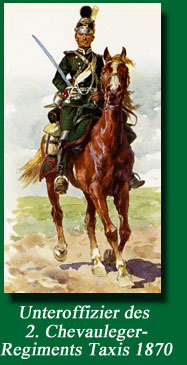 |
En 1909 sa garnison est trasnférait à Ratisbonne lieu de résidence des princes de Thurn et Taxis Le dernier propriétaire du régiment fut du 26 Juillet 1885 jusqu'à sa dissolution Albert , prince de Thurn et Taxis .
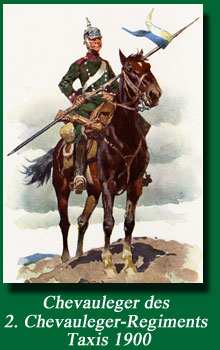 |
Au début de la Première Guerre mondiale , le régiment est en Lorraine en protection de la frontière . Il se deplace ensuite en Septembre 1914 dans une zone située entre la Meuse et de la Moselle
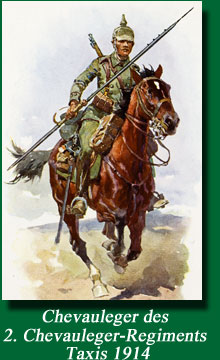 |
Les escadrons sont ensuite utilisé dans le stranchées commes troupes d'appoint affectés à différentes divisions d'infanterie bavaroises Les différents escadrons ont participé à toutes les grandes offensives sur le front de l'Ouest jusqu'à l'automne de 1918 .
Seule le premièr Escadron fut entre Avril 1914 et Juin 1916, affecté au 11. bayerischen Infanteriedivision en Galice Pologne et Serbie
Après l'armistice, en Novembre 1918, les escadrons regagnent en Décembre Ratisbonne . Le régiment est démobilisé et dissous le 1 Avril 1919 après 45 campagnes , mettant ainsi fin à l'histoire de l'un des deux plus anciens régiments de cavalerie bavaroise .
La tradition du régiment fut ensuite relevé par le 3. Eskadron des (bayerischen) Reiter-Regiments Nr. 17 à Ansbach .
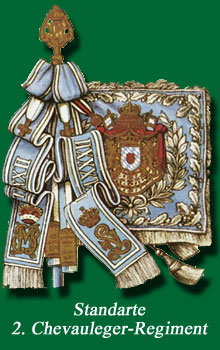 |
The Königlich Bayerisches 2. Chevauleger-Regiment Taxis is one of the oldest Bavarian cavalry regiments and 1682 leading to the creation of the standing army by the young Bavarian Elector Maximilian II Emanuel ( "The Blue King " ) 29 June built as a " regiment of horse Louis Marquis de Beauvau de Croan " . First, a cuirassier regiment , then in 1790 a regiment of dragoons , and finally from 1811 Chevauleger Regiment , the troupe changed over the centuries from Heavy to Light Cavalry .
In his history of the regiment 237jährigen often changed the peacetime locations in Bavaria , where you could not really talk about locations , especially in the first few decades , as the cavalry regiments were distributed at this time in the country for many villages. Locations over the centuries were: Dingolfing , Ried , Braunau , Ulm , Memmingen, Amberg , Wasserburg , Rosenheim , Neumarkt ok , Munich , Ingolstadt, Neuoetting , Landsberg, Speyer , Zweibrücken , Ansbach, Dillingen / Donau (1872 - 1909) and from 1909 until the dissolution finally Regensburg.
Since 1747 , the regiment "Taxis " was because it was closely connected with the house of Thurn and Taxis and traditionally a prince or prince was the house of a regiment .
Elector Max Emanuel II had just in time in 1682 situated in a field camp in Schwabing , the new Bavarian standing army , when in 1683 and the outbreak of the great war against the Turks in Hungary to 1688 was the first shiny test with the siege of Vienna. The highlight was the daring capture of Belgrade by the Elector in 1688 , the Emperor Leopold I served as a commander and supported with its Bavarian troops . Multiple sat the young Elector in the Hungarian campaigns at the top of his cuirassier regiments to battle decisive attacks.
When the French king Louis XIV 1689, the Rhine Palatinate invaded , the Bavarian troops were withdrawn from Hungary and the bulk of the Bavarian army with the regiment fought in the so-called Palatine- the Orleans War from 1689 to 1697 in nine other campaigns in the Upper Rhine and the Netherlands sides of the emperor and the empire
 |
After a brief period of peace , in which the regiment had to give reasons of cost, his horses , broke 1702 of the Spanish Succession war , at the Elector Max Emanuel II on the side of the French stood against the Allies to the emperor and the maritime powers of England and Holland . First, the challenged elector in 1703 very successfully against the harassing him in Bavaria Allies , but in 1704 it came to the momentous defeat of the combined French- Bavarian army of Blenheim . Max II Emanuel of Bavaria had to leave and walked with remnants of his troops in the Netherlands, where he was governor and where he continued to fight on the side of the French. The regiment followed him to the Netherlands and fought there until the end of the war 1714. Since the recruitment of Bavaria was no longer possible , many French and Dutch served in the regiment . After the war, Max II Emanuel of Bavaria was restored and the regiment returned to his homeland. The public finances were extremely disorganized and again gave the regiment in the following period of peace in its entire stock of horses from .
 |
 |
The new Elector Karl Albrecht was the major power in Bavaria claims not to . When Emperor Charles VI . In 1740 and died in the male line of the Habsburgs with him , rose after the accession of Maria Theresa , the elector claims to the Austrian hereditary lands . Even crowned as Charles VII Emperor of Germany , Karl Albrecht fought in the War of Austrian Succession from 1741 until his untimely death in 1745 against the Austrians . The regiment took part in these five very eventful campaigns in which initially Bohemia conquered , then lost and the Bavarian heartland were highly competitive. The new Elector Max III . Joseph closed immediately peace with Maria Theresa and asked her now Bavarian auxiliary troops in the remaining Austrian successes War to 1748 and then in the Seven Years' War, 1757-1762 . The Cuirassiers "Taxis " but did not take part in it and remained demobilized in Bavaria. A majority of the horse has been sold.
The regiment was in 1785 a so-called Cavalry Regiment , then in 1786 again a cuirassier regiment and 1790 Dragoon Regiment , which it completed the reclassification of Light Cavalry .
The long period of peace ended with the Napoleonic wars. 1800 took the regiment still in the campaign against France on the side of Austria in part , which ended in the disastrous battle of Hohenlinden . Under the Elector Max IV Joseph of Bavaria took the pivot allies to Napoleon , who gave him large area growth , but also brought the royal crown warlike times. The regiment was in 1805 against Austria and fought 1806/ 07 against Prussia especially in Silesia. The war of 1809 then brought on 22 April with the Battle of Eggmühl one of the greatest glories of the regiment. As part of the Cavalry Brigade Seydewitz (taxis dragoons and boys Hoven Chevaulegers ; those of the present 2nd and 6th Chevauleger Regiment ) took the regiment in a battle decisive attack, the dominant Austrian artillery positions and captured 16 guns . General of Seydewitz was appointed Knight of the Order of Max Joseph purpose.
 |
1812 , the regiment took part in the Russian campaign of Napoleon and became almost completely wiped out. 1813 reorganized in Bavaria took the regiment after the break Bavaria until 1815 in three campaigns against Napoleon in part . The regiment participated in the Battle of Hanau ( 28 to 30 October 1813) and the capture of Chalons (5 July 1815) in part . The previous Dragoon Regiment was on 29 April 1811 to 2 Chevauleger Regiment was " Prince of Thurn and Taxis " reclassified . Wore the regiment since 1682 , a yellow or white uniform color, is this now wandette in the steel green light cavalry . It returned in 1815 for a long period of peace in the new location Ansbach back . In 1848, then , the regiment was named second Chevauleger Regiment "Taxis ", which continued to exist until dissolved.
 |
In the main campaign against Prussia in 1866 , the regiment consisted of four major battles on the Tauber , and then returned in September back to Ansbach. In the 1870/71 war against France , the regiment during the Second Bavarian Corps was
 |
used as divisional cavalry. It took part in the march against white castle part , led patrols against Worth and was in the shaft of Sedan (September 1, 1870) used to secure the artillery. By the end of the war it was used to secure the siege of Paris ring .
1909 was the regiment with a new peace Regensburg location. Thus, the regiment was stationed directly at the headquarters of the Prince of Thurn and Taxis . The last owner of the regiment until the dissolution was since 26 July 1885 Alber , Prince of Thurn and Taxis .
 |
With the outbreak of the First World War, the regiment moved as border protection into Lorraine , and participated in the bay in Lorraine, where the French advance was refused to the Reich. In September 1914, the regiment of Lorraine was moved to the area between the Meuse and Moselle . There it was used until mid- 1916 at the grave of war as well as to the rear fuses. The squadrons of the regiment were then assigned to different Bavarian infantry divisions , which the regimental association was resolved surgically. The various squadrons took part in all the major hostilities on the Western Front until the autumn of 1918. Only the first Squadron was from April 1914 to June 1916 the 11th Bavarian Infantry Division in Galicia , Poland and Serbia assumed.
 |
After the armistice in November 1918, the squadrons returned in December to Regensburg . The regiment was demobilized on 1 April 1919 resolved. After 45 campaigns, thus ending the story of one of the two oldest Bavarian cavalry regiments. The tradition of the regiment was later used by the third Squadron of the ( Bavarian ) Reiter- Regiment No. 17 continued in Ansbach.
Bavarian Regimental Names 1790 -1814 (Internet)
Guarde Guard
1790
Liebgarde der Trabanten (Palace Guards)
Leibgarde der Hartschiere (Royal Bodyguard)
1814
Grenadier-Garde-Regiment - 3 battalions, each of 4 companies of 168 personnel, regimental HQ 47 personnel.
Gardes du Korps – 2 squadrons, each of 132 personnel. Regimental HQs 17 personnel.
Infanterie Ligne Line Infantry
1790:
A regiment consisted of 2 battalions, each of 4 companies of 150 men and 180 men on mobilisation. Regimental HQ comprised 16 personnel.
1st Grenadier-Regiment und Leib-Infanterie-Regiment
2nd Grenadier-Regiment Kurprinz
3rd Grenadier-Regiment Graf Ysenburg
disbanded 1799
4th Grenadier-Regiment Baden
disbanded 1799
1st F?siler-Regiment Herzog von Zweibr?cken
2nd F?silier-Regiment Prinz Wilhelm von Birkenfeld
3rd F?silier-Regiment Rodenhausen
4th F?silier-Regiment de la Motte
5th F?silier-Regiment von Wahl
6th F?silier-Regiment Pfalzgraf Max
7th F?silier-Regiment von Zedtwitz
disbanded 1799
8th F?silier-Regiment von Rambaldi
9th F?silier-Regiment von Weichs
10th F?silier-Regiment Joseph Hohenhausen
disbanded 1799
11th F?silier-Regiment von Preysing
12th F?silier-Regiment von Belderbusch
disbanded 1799
13th F?silier-Regiment Moritz von Isenburg
disbanded 1799
14th F?silier-Regiment von Kling
disbanded 1799
1799:
Regiments were now known by their title (e.g. Leib-Regiment).
1st Linien-Infanterie-Leib-Regiment
2nd Linien-Infanterie-Regiment Kurprinz
3rd Linien-Infanterie-Regiment Herzoh Karl
4th Linien-Infanterie-Regiment vacant von Weichs
1804 renamed “von Salern”
5th Linien-Infanterie-Regiment Graugeben
1800 renamed “von Preysing”
6th Linien-Infanterie-Regiment Herzog Wilhelm
7th Linien-Infanterie-Regiment Zedtwitz-Stengel
1804 renamed “von Morawitsky”
8th Linien-Infanterie-Regiment Herzog Pius
9th Linien-Infanterie-Regiment Graf von Ysenburg
10th Linien-Infanterie-Regiment von Junker
1800 renamed “Pompei-Dalwigk”;
1804 renamed “von Junker”
11th Linien-Infanterie-Regiment Schlossberg
1801 renamed “von Kinkel”
12th Linien-Infanterie-Regiment von Löwenstein-Wertheim (raised in 1803)
May 1803 battalions were increased to 5 companies – 1 grenadier and 4 fusilier.
1806:
Regiments were now known by their numbers as well their titles.
1st Linien-Infanterie-Leib-Regiment
1811 renamed “König”
2nd Linien-Infanterie-Regiment Kurprinz
1806 renamed “Kronprinz”
3rd Linien-Infanterie-Regiment Herzoh Karl
1806 renamed “Prinz Karl”
4th Linien-Infanterie-Regiment von Salern
1811 renamed “Sachsen-Hildburghausen”
5th Linien-Infanterie-Regiment von Preysing
6th Linien-Infanterie-Regiment Herzog Wilhelm
7th Linien-Infanterie-Regiment von Morawitsky
1806 renamed “Löwenstein-Wertheim”
8th Linien-Infanterie-Regiment Herzog Pius
9th Linien-Infanterie-Regiment Graf von Ysenburg
10th Linien-Infanterie-Regiment von Junker
11th Linien-Infanterie-Regiment von Kinkel
1806 transferred to Grand Duchy of Berg;
1807 new regiment raised;
1811 disbanded
12th Linien-Infanterie-Regiment von Löwenstein-Wertheim
disbanded in 1806 as a result of a mutiny.
13th Linien-Infanterie-Regiment
1805 raised;
1811 renumbered as 11th
14th Linien-Infanterie-Regiment
1806 raised;
1811 renumbered as 13th
15 September 1806 company strength increased to 185 men.
1809 regimental strength 2 field battalions each of 5 companies (1 grenadier and 4 fusilier); 1 fusilier company from each battalion served as a depot company. Companies comprised 185 personnel including 20 sch?tzen (supposedly rifle armed); in March numbner of sch?tzen increased to 36 (only 7 of whom were rifle armed).
29 April 1811 regimental strength now 2 field battalions each of 4 fusilier companies, 1 grenadier company and 1 "Schützen-Kompanie". Each regiment also had a depot battalion of 4 fusilier companies.
In 1814 new 12th and 14th regiments were raised.
Light Infantry
The light infantry battalions were formed in 1804 with the amalgamation of several existing units of Feld-jager-korps, and were given official line status., and was commanded by a Oberstleutnant, with a major as 2IC and a reduced staff. Company strengths were as for the line regiments.
1790:
1st Feld-Jäger-Regiment von Schweicheldt
2nd Feld-Jäger-Regiment F?rst Ysenburg
1799:
1st Leichte Infanterie Bataillon Metzen
2nd Leichte Infanterie Bataillon Clossmann
1804 renamed “Vicenti”
1805 renamed “Ditfurth”
3rd Leichte Infanterie Bataillon 1st Salern
1804 renamed “von Preysing”
4th Leichte Infanterie Bataillon 2nd Salern
1804 renamed “Stengel”
1803: two further battalions raised
5th Leichte Infanterie Bataillon de la Motte
6th Leichte Infanterie Bataillon Lessel
1804 renamed as “Weinbach”
March 1804 companies had an operational strength of 250 men. In peacetime this was reduced to 155 men, and during wartime the field strength was 200 men (reinforcements were reservists), the other 50 men went into the reserve company.
1806:
1st Leichte Infanterie Bataillon Metzen
1807 renamed “Habermann”
1809 renamed “Gedoni”
1811 renamed “Hertling” then “Fick”
2nd Leichte Infanterie Bataillon Ditfurth
1808 renamed “Wreden”
1811 renamed “Treuberg” then “Merz”
3rd Leichte Infanterie Bataillon von Preysing
1808 renamed “Bernclau”
1811 renamed “Scherer”
1814 formed new 12th Linien-Infanterie-Regimentwith Wurzburg Infantry Regiment
4th Leichte Infanterie Bataillon Stengel
1806 renamed “Zoller”
1807 renamed “Wreden”
1809 renamed “Donnersberg”
1810 renamed “Theobald”
1813 renamed “Cronegg”
5th Leichte Infanterie Bataillon de la Motte
1807 renamed “Dalwigk”
1808 renamed “Buttler”
1812 renamed “Herrmann”
1814 renamed “Treuberg”
6th Leichte Infanterie Bataillon Weinbach
1806 renamed “Taxis”
1809 renamed “La Roche”
1812 renamed “Palm”
1814 renamed “Flad”
1814 formed new 14th Linien-Infanterie-Regiment with Frankfurt Infantry Regiment
7th Leichte Infanterie Bataillon G?nther (raised in 1808)
1809 renamed “von Treuberg”
1811disbanded).
1806 September company strength increased to 185 men.
1809 a battalion comprised 5 companies - 1 'Karabinier-Kompanie' & 4 centre companies (Ordinarkompanien); 1 centre company served as a depot/reserve company. Companies comprised 185 personnel including 20 sch?tzen (supposedly rifle armed); in March number of sch?tzen increased to 36 (only 7 of whom were rifle armed).
1807 Tiroler-Jager-Bataillon raised with 4 'Ordinar-jäger-kompanie'. Company strength as for the line or light infantry plus 20 men rifle armed designated as sharpshooters. In 1808 its personnel were absorbed into the new 7th Leichte Infanterie Bataillon.
1811Organisation was as for the line infantry battalions each battalion having a strength of one elite heavy company, 'Karabinier-Kompanie', 1 'Schützen-Kompanie', and four centre companies 'Ordinarkompanien'
Freiwilligen-Jäger-Korps 1805-14
1805 'Jäger-Korps-zu-fuss' was formed on a Freiwillige, volunteer basis. The unit had an intermittent existence, being stood down in 1808.
1809 re-raised as the 'Freiwilligen-Jäger-Corps zu Fuss' and stood down again in 1810.
1813 October raised once more as a 2 battalion unit. Each battalion organised on the line system of four centre companies 'Ordinar-jäger-kompanien', two elite companies Grenadier-jäger, and Schützen-jäger-kompanie.
During the 1814 campaign a 3rd battalion was raised but only attained an active strength of two elite and two centre companies.
Jäger-Bataillonen
1815 two battalions of jägers were formed. Each battalion with the normal line establishment of six companies - two elites and four centre.
Gendarmes zu Fuss 1813-14
In 1813 a small corps of gendarmes were raised and organised into reduced companies to act as military police.
Cavalry
Chevauleger and Dragoon regiments were organised into 6 squadrons, each of 132 personnel. The 7th Chevauleger Regiment formed with initial strength of 4 squadrons in 1813, increased to 6 in 1814; unlike the other Chevauleger it had 1 elite 'Flankerkompanie' flanker or skirmisher company. Regimental HQs 17 personnel.
The Uhlan Regiment had 4 squadrons each of 132 personnel. After close of hostilities in 1814 increased to 6 squadrons. Regimental HQ 17 personnel
The Landhusaren Regiment was raised in 1813 with 5 squadrons each of 147 personnel; was increased to 8 squadrons in May 1814. Regimental HQ 17 personnel
1790:
1st K?rassier-Regiment Minucci
1804 1st Dragoner-Regiment Minucci
1811 1st Chevau-Légers-Regiment
2nd K?rassier-Regiment Winckelhausen
1799 4th Chevau-Légers-Regiment then 1st Chevau-Légers-Regiment Kurf?rst
1804 2nd Chevau-Légers-Regiment Kurf?rst
1806 renamed “König”
1811 4th Chevau-Légers-Regiment König
1st Dragoner-Regiment Leib-Dragoner
1801 1st Dragoner-Regiment
1803 disbanded
2nd Dragoner-Regiment F?rst Taxis
1811 2nd Chevau-Légers-Regiment F?rst Taxis
1st Chevau-Légers-Regiment Prinz Leiningen
1799 4th Chevau-Légers-Regiment Prinz Leiningen
1803 3rd Chevau-Légers-Regiment Prinz Leiningen
1811 5th Chevau-Légers-Regiment Prinz Leiningen
2nd Chevau-Légers-Regiment La Rosée
1799 3rd Chevau-Légers-Regiment vacant F?rst Bretzenheim
1801 disbanded
3rd Chevau-Légers-Regiment Wahl
1799 2nd Chevau-Légers-Regiment Fugger
1806 1st Chevau-Légers-Regiment Kurprinz
1811 1st Chevau-Légers-Regiment Kronprinz
4th Chevau-Légers-Regiment Bubenhofen (raised 1803)
1811 6th Chevau-Légers-Regiment Bubenhofen
National-Chevau-Légers-Regiment (raised 1813) then 7th Chevau-Légers-Regiment Prinz Karl von Bayern
Uhlanen-Regiment (raised 1813)
Gendarme-zu-Pferde 1813-14
Freiwilligen-Husaren-Regiment 1813-14
Freiwilligen-Jäger-zu-Pferde
Raised in 1805 from volunteers and comprised 2 squadrons. Treated as an elite corps and drafted into the field army as officers and N.C.O.s. In 1806 served on headquarters duties and staff escort.
Following the close of hostilities in 1815 two regiments each of Kürassiers and Hussars were formed but saw no part in the actions of the Napoleonic era.
Artillery
1790 there were 2 battalions, each of 4 companies. A company served 6 cannon & 2 howitzers.
1809 - Artillerie-Regiment comprised 4 battalions, each composed of 3 foot companies, 1 light company (horse battery), and 1 depot company (Bavaria’s fortress artillery).
1812 the regiment had a strength of twenty batteries - 6 light horse artillery and the remaining 14 foot batteries divided into light and heavy batteries armed with either 6 pdr cannon or 12 pdr cannon and 7 pdr howitzers, and horse batteries equipped with 6 pdr cannon.
Foot batteries generally comprised of 8 pieces each, heavy batteries: 6 x 12 pdr cannon and 2 howitzers; light batteries 6 x 6 pdr field guns and 2 howitzers. Horse batteries had 6 x 6 pdr cannon.
5th, 7th, 8th, 10th, and 11th Foot Batteries were light batteries, and the remainder 12 pdr Heavy Batteries, (composition of 13th and 14th unknown). The 1st to 6th Light Horse Batteries were armed with six 6 pdr field guns.
Landwehr and National-Feld-Bataillonen
1806 national militia raised to assist with the garrison duties and general service within the state borders.
1809 - in March Napoleon ordered formation of 12 bataillons de milice but due to finacial problems & the lack of qualified officers only 6 reserve battalions, each of 4 companies of 135 personnel and battalion HQ of 8 personnel were formed. They were designated Nationalgarde I Klasse (National Guard First Class). In late April a Landes-Defensionsbataillon was formed.
Gebirgssch?tzen of 3 divisions formed – 1st division Trauenstein district (500 men); 2nd division Rosenheim district (1,000 men); & 3rd division Garmisch district (1,000 men).
Nationalgarde II Klasse (National Guard Second Class) raised. Each of Bavaria’s 15 Kreis (counties – named after rivers) were ordered to organise Mobile Legionen (Mobile-Legions) of 4 to 8 battalions, each of 4 companies of 176 personnel (including 30 sch?tzen), battalion HQ 8 personnel. The counties were: main; Pegnitz; Naab; Rezal; Altm?hl; Oberdonau; Lech; Regen; Unterdonau; Isar; Salzach; Iller; Inn; Eisach; & Etsch.
Local militias (B?rgergarde) were also raised as Nationalgarde III Klasse (National Guard Third Class)
1813 Mobile-Legions re-organised and renamed the Nationalfeldbataillon, (Nationalgarde II Klasse) with terms of service allowing them to serve with the regular army. At least 20 battalions, each bearing the name of its recruitment district:
Isarkreises; Salzakreises; Oberdonaukreises; Regenkreises; Unterdonaukreises; Mainkreises; Illerkreises; Wurzburg; Rezatkreises; Aschaffenburg;
Garrison Regiment
In 1809 comprised 8 stations(became companies in 1811): Rothenberg (HQ); Nymphenburg; Oberhaus; Rosenberg; Eichstadt; W?rzburg; Stadtamhof; & Donauworth.
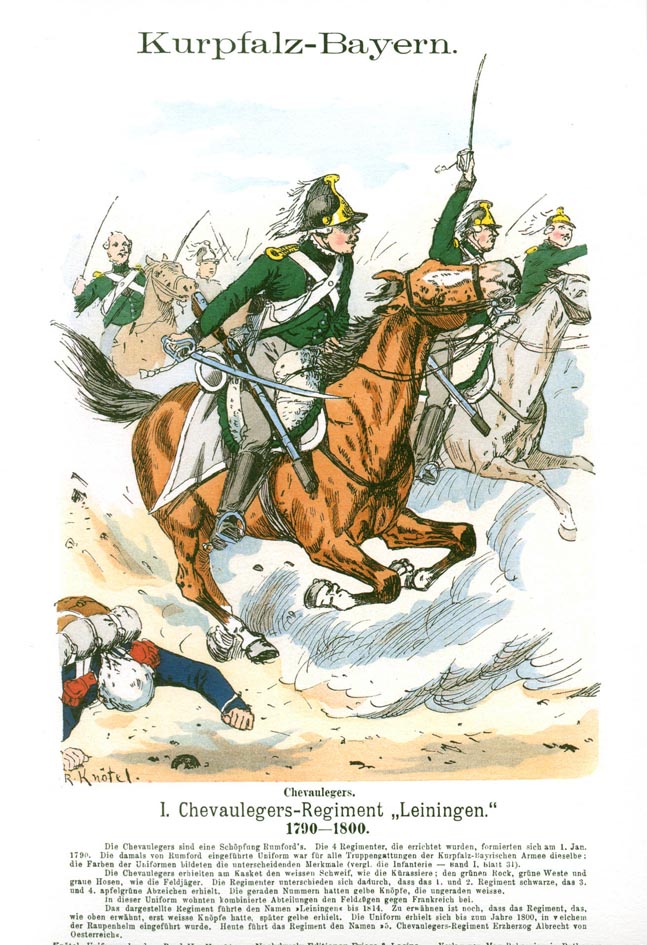 |